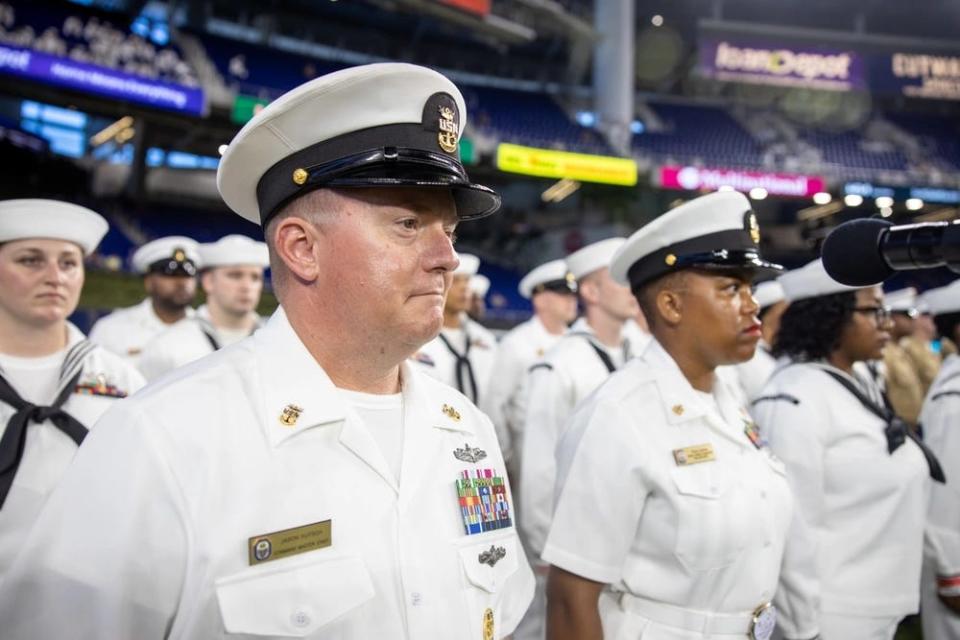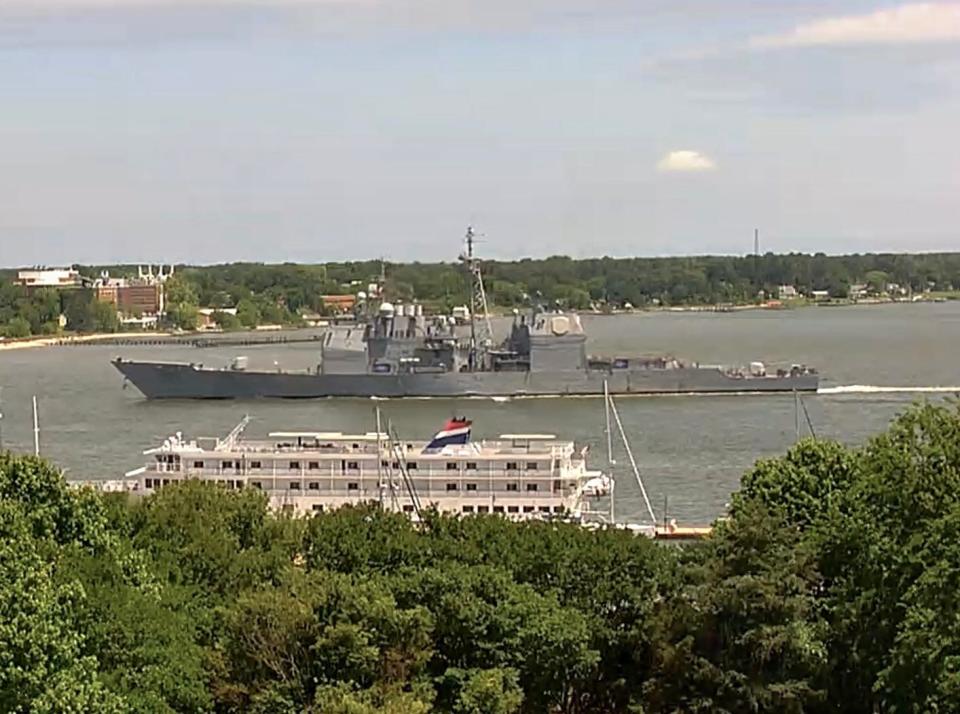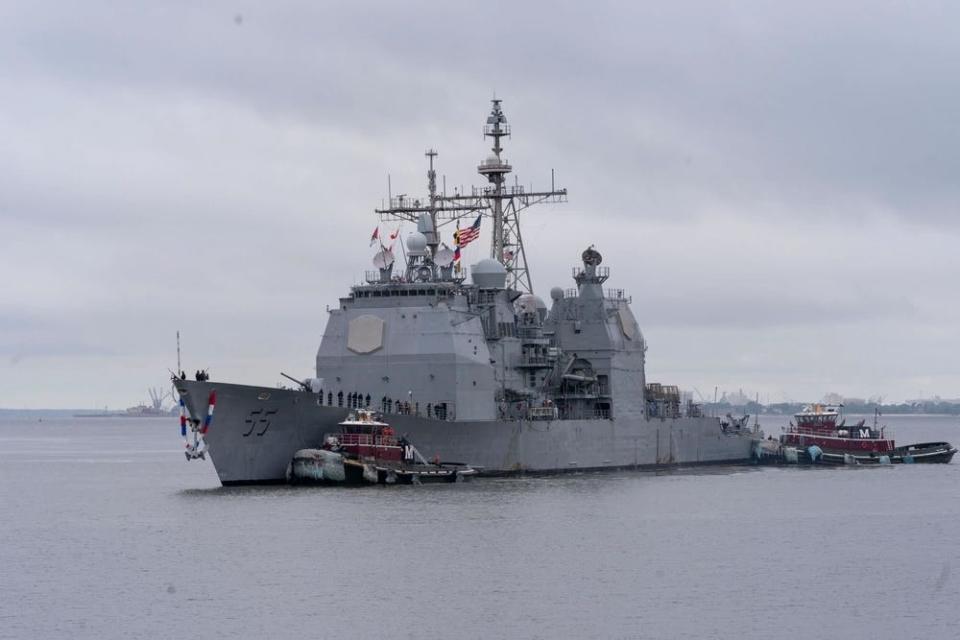Photos show the final cruise of the USS Leyte Gulf as the US Navy phases out its cruiser fleet
USS Leyte Gulf returned home after its last deployment, concluding nearly four decades of service.
The guided-missile cruiser patrolled the South Atlantic to counter drug trafficking in the region.
The ship is set to be decommissioned in 2027 as the Navy retires its aging Ticonderoga-class fleet.
USS Leyte Gulf completed its final deployment earlier this month, concluding nearly four decades of service.
The guided-missile cruiser returned to its homeport in Norfolk, Virginia, on May 17 after three-and-a-half months in the South Atlantic on security operations and counter drug trafficking in the region.
Photos of the Leyte Gulf's final deployment captured its port visits to Cuba and Brazil, its debut in the inaugural Fleet Week Miami, and the massive drug busts by the ship's crew.
Norfolk, Virginia

On January 28, the Leyte Gulf departed from Naval Station Norfolk to "maintain maritime security and interoperability" in the Caribbean and South America.
The ship was crewed by more than 40 officers and nearly 350 sailors who "continued to display a high level of proficiency and readiness" while the Leyte Gulf spent the fall of 2023 in the Western Atlantic preparing for its last deployment, according to the Navy.
"I admire the resiliency of the crew aboard Leyte Gulf," Vice Adm. Doug Perry, the commander of US 2nd Fleet, said in a statement. "Their commitment to the mission in the South Atlantic enhances maritime security through sustained naval presence."
One final deployment

The ship was named after the Battle of Leyte Gulf, the largest naval battle of World War II, in which the US Navy defeated the Japanese navy off the coast of Leyte Island in the Philippines.
Built by Ingalls Shipbuilding, the Ticonderoga-class cruiser was delivered and commissioned in 1987. Propelled by four gas turbine engines, the ship can reach speeds of up to 32 knots and has a displacement of about 9,600 tons.
The Leyte Gulf can carry more than 100 missiles for surface attacks, air defense, and anti-submarine warfare. It is also armed with deck guns, machine guns, and radar-guided air defense guns.
The 567-foot vessel can also accommodate two MH-60R Seahawk helicopters.
Guantánamo Bay, Cuba

On its way to the South Atlantic, the Leyte Gulf made a scheduled port visit to the US naval base in Guantánamo Bay, Cuba, in mid-March.
Sea-and-anchor evolution

Photos showed the crew aboard USS Leyte Gulf conducting a sea-and-anchor evolution, navigating and maneuvering the ship safely into Naval Station Guantánamo Bay.
South Atlantic

One of the main objectives of the Leyte Gulf's deployment to the South Atlantic was to keep "illegal drugs from reaching the shores of the US and its regional partner nations," according to a statement from the Naval Surface Force Atlantic.
Patrolling the Caribbean

With assistance from Helicopter Maritime Strike Squadron 50, known as the "Valkyries," and the US Coast Guard Law Enforcement Detachment team, the cruiser intercepted three vessels in the Caribbean Sea less than a month after it deployed.
Nearly 1,720 kilograms of cocaine were seized in the three interdictions throughout February, worth a total of more than $42 million, according to a Navy statement.
On February 6, the Coast Guard boarding team and the Leyte Gulf's helicopter aircrew recovered 520 kilograms of cocaine. On February 15, they seized 600 kilograms of cocaine and another 600 kilograms of cocaine was recovered less than two weeks later.
"Our Leyte Gulf team was ready when called upon to execute all three interdictions," Capt. Nathan Diaz, the ship's commanding officer, said in a statement. "The successful seizure of more than $42 million in illicit drugs is a testament to the interoperability of our partner nations, the Coast Guard and the Leyte Gulf team."
A massive maritime drug bust

While patrolling in the Atlantic in late March, a Navy helicopter detected a 55-foot semi-submersible vessel likely smuggling narcotics about 132 miles off the coast of Trinidad and Tobago, according to court documents. The Coast Guard commandeered the boat and detained four individuals aboard.
"Spotting this vessel was like finding a needle in the haystack," Lt. Cmdr. Travis Lee, Leyte Gulf's senior aviator, said in a statement. "I've been doing this for seven years and not once been able to find and acquire such an asset until now."
In its largest drug bust of the Leyte Gulf's deployment, Navy and Coast Guard crews seized about 2,370 kilograms of cocaine — more than 5,000 pounds — in about 100 brick-shaped packages aboard the drug-smuggling boat, which was later used as a target for live-fire training.
The four men — three Colombian nationals and one dual French-Columbian — were indicted on drug trafficking charges by a federal grand jury in Puerto Rico.
Testing its unmanned fleet

USS Leyte Gulf ran small boat operations in support of the US Fourth Fleet's ongoing campaign to integrate unmanned surface vehicles (USVs) into the US Navy's manned fleet.
Operation Windward Stack aims to achieve the US Navy's long-term vision of building a reliable hybrid fleet consisting of manned and unmanned vessels working together to conduct maritime operations.
Last September, California-based drone company Saildrone first deployed 10 unmanned robotic boats, known as "Voyagers," off the coast of Key West, Florida, to test and refine the unmanned systems.
It is difficult to spot drug-runners across the breadth of the Caribbean Ocean, especially when they are narco-subs whose bulk largely rides beneath the waves. More eyes, the thinking goes, will allow manned ships to detect more suspected drug runners and dispatch ships to intercept them.
The Navy plans to use ocean drones to improve maritime domain awareness "by detecting and quantifying targets that pass within range of the Saildrones' sensors," according to a press release.
The American Bureau of Shipping classifies the 33-foot Voyager as a light warship, which typically operates in riverine, coastal, or littoral environments.
Aside from the Voyager, Saildrone operates two other ocean drone variants called the Explorer and the Surveyor.
Rio de Janeiro, Brazil

While sailing through the South Atlantic, the Leyte Gulf made a scheduled port visit to Rio de Janeiro, where US and Brazilian sailors participated in joint training exercises.
Moored at Base Naval do Rio de Janeiro for a four-day liberty port visit, US sailors worked with the Brazilian navy to "increase interoperability between the two Marines, enhance the level of training and readiness of their ships, and contribute to strengthening cooperation ties between the participating countries," according to the Brazilian navy.
The @USNavy (🇺🇸) cruiser USS Leyte Gulf (CG-55) has arrived in Rio de Janeiro, Brazil (🇧🇷) as part of its deployments with @Southcom.
Her hull is looking a bit rough with rust, but it’s likely due to the long deployment to South America pic.twitter.com/w539ZYgUzh— SA Defensa (@SA_Defensa) April 11, 2024
The @USNavy (🇺🇸) cruiser USS Leyte Gulf (CG-55) conducted exercises with the @marmilbr (🇧🇷) frigate F União (F-45) off the coast of Rio de Janeiro. pic.twitter.com/Xw991yuCio
— SA Defensa (@SA_Defensa) April 24, 2024
Crews from the Leyte Gulf and Brazilian frigate União conducted several operational exercises, such as "rapid response to the actual use of armaments; interrogation and approach with the ships' Visit and Inspection Groups; and flag communication," according to the Brazilian navy.
The AH-11B Super Lynx, a Brazilian multi-role military helicopter, also ran landing drills aboard the Leyte Gulf.
Miami, Florida

The Leyte Gulf returned stateside to make a debut at the inaugural Fleet Week Miami, which previously took place in Fort Lauderdale for over three decades.
For a week in early May, the vessel docked at Port Miami alongside the Nimitz-class aircraft carrier USS Harry S. Truman, the Wasp-class amphibious assault ship USS Bataan, and fellow Ticonderoga-class cruiser USS Normandy. The Coast Guard's medium endurance cutter, USCGC Seneca, also made an appearance.
A display of US naval power

More than 7,000 sailors and Marines participated in the Fleet Week festivities.
"We've come through, flooding the zone, so that we can engage with the folks of Miami and let them understand what it's like to be part of the sea services," Navy Adm. Daryl Caudle, commander of the US Fleet Forces Command, said in public remarks.
Norfolk, Virginia

After three and a half months at sea, the Leyte Gulf returned to a warm yet bittersweet homecoming at Naval Station Norfolk on May 17.
"I admire the resiliency of the crew aboard Leyte Gulf," Vice Adm. Doug Perry, commander of the US 2nd Fleet, said in a statement. "Their commitment to the mission in the South Atlantic enhances maritime security through sustained naval presence."
'A model for maritime teamwork'

Perry commended sailors aboard the Leyte Gulf for completing the vessel's final deployment, calling the crew "a model for maritime teamwork" after conducting multiple drug interdictions alongside the Valkyries helicopter squadron and the Coast Guard.
"This is a profound final chapter for one of the Navy's finest ships, and their crew should be proud of all they accomplished," Perry said.
Diaz, the commanding officer of Leyte Gulf, echoed the sentiment, recalling the "generations of sailors who have manned the helm" of the storied warship.
"This ship is full of history. Each period brings its own far-off journeys, along with generations of Sailors who have manned the helm," Diaz said in a statement. "Our last deployment was full of Sailors who made their own mark on the story of this great warship."
"Though our namesake comes from a battle long ago, the US is still performing with a level of combat expertise and professionalism that we've always had as we protect the homeland," he added.
Yorktown, Virginia

The Leyte Gulf briefly moored at Naval Weapons Station Yorktown for two days to offload ammo before returning home on May 22.
Modernizing its cruiser fleet

The Leyte Gulf is scheduled to be decommissioned in 2027 as the Navy retires its aging and costly Ticonderoga-class cruiser fleet.
The Navy proposed retiring its aging and costly ships, like the Leyte Gulf, to grow its unmanned fleet and build more modern ships. The proposal drew some early opposition after Congress blocked attempts to retire ships ahead of schedule.
The Navy faces yearslong delays on some of its highly anticipated shipbuilding projects due to supply chain issues and labor shortages.
Lawmakers argued the aging yet operational ships should be kept in active service to prevent a capability gap in coming years, as adversaries like China and Russia grow their own naval fleets, threatening the US' global undersea dominance.
China has already outpaced American shipbuilding, and the US Department of Defense said the country now has the largest navy in the world —comprised of nearly 400 vessels and counting.
Correction: May 31, 2024 — An earlier version of this article misstated the length of its active service. It has been in the US fleet for approaching four decades.
Read the original article on Business Insider

 Yahoo News
Yahoo News 
